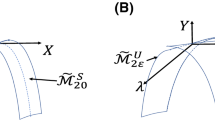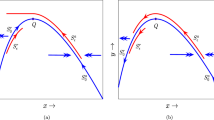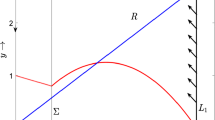Abstract
Over the past few decades, the study of complex oscillations in slow–fast systems has been a focal point of research. Within the realm of slow–fast systems theory, the determination of the singular Hopf bifurcation and maximal canard locations relies on computing the first Lyapunov coefficient, based on the genericity condition that it is nonzero. This manuscript seeks to broaden these results to scenarios where the first Lyapunov coefficient becomes zero. To achieve this, the analytical expression of the second Lyapunov coefficient is derived, and an exploration of the normal form for codimension-2 singular Bautin bifurcation in a singularly perturbed Holling type-III predator–prey system with a weak Allee effect is conducted, explicitly identifying locally invertible parameter-dependent transformations. Utilizing geometric singular perturbation theory, the normal form theory of slow–fast systems, and the blow-up technique, this research unveils a diverse array of rich and complex nonlinear dynamics. This includes, but is not limited to, the existence of relaxation oscillations, canard phenomena, singular Hopf bifurcation, singular Bautin bifurcation, and saddle-node bifurcation of the canard cycle. Furthermore, numerical simulations are carried out to substantiate the theoretical findings.








Similar content being viewed by others
Data availability
Data sharing is not applicable to this article as no datasets were generated or analysed during the current study.
References
Ankur, Jiwari, R.: New multiple analytic solitonary solutions and simulation of (2+ 1)-dimensional generalized Benjamin-Bona-Mahony-Burgers model. Nonlinear Dyn. 1–29 (2023)
Arnold, V.I.: Dynamical Systems V: Bifurcation Theory and Catastrophe Theory, vol. 5 (Encyclopaedia of Mathematical Sciences). Springer, Berlin (1994)
Atabaigi, A.: Canard explosion, homoclinic and heteroclinic orbits in singularly perturbed generalist predator–prey systems. Int. J. Biomath. 14(01), 2150003 (2021)
Bai, D., Kang, Y., Ruan, S., Wang, L.: Dynamics of an intraguild predation food web model with strong Allee effect in the basal prey. Nonlinear Anal. Real World Appl. 58, 103206 (2021)
Courchamp, F., Berec, L., Gascoigne, J.: Allee Effects in Ecology and Conservation. Oxford University Press, Oxford (2008)
Dumortier, F., Roussarie, R.: Canard Cycles and Center Manifolds, vol. 577. American Mathematical Society, Providence (1996)
Fenichel, N.: Geometric singular perturbation theory for ordinary differential equations. J. Differ. Equ. 31(1), 53–98 (1979)
FitzHugh, R.: Mathematical models of threshold phenomena in the nerve membrane. Bull. Math. Biophys. 17(4), 257–278 (1955)
Garrett, B., Gian-Carlo, R.: Ordinary Differential Equations. Wiley, Boston (1982)
Getz, W.M.: A hypothesis regarding the abruptness of density dependence and the growth rate of populations. Ecology 77(7), 2014–2026 (1996)
Han, X., Bi, Q.: Slow passage through canard explosion and mixed-mode oscillations in the forced Van der Pol’s equation. Nonlinear Dyn. 68(1–2), 275–283 (2012)
Hek, G.: Geometric singular perturbation theory in biological practice. J. Math. Biol. 60(3), 347–386 (2010)
Hsu, S.B., Hwang, T.W., Kuang, Y.: Global analysis of the Michaelis-Menten-type ratio-dependent predator-prey system. J. Math. Biol. 42, 489–506 (2001)
Hsu, S.B., Hwang, T.W., Kuang, Y.: Global dynamics of a predator–prey model with Hassell–Varley type functional response. Discrete Contin. Dyn. Syst. Ser. B 10(4), 857–871 (2008)
Hsu, T.H., Ruan, S.: Relaxation oscillations and the entry-exit function in multidimensional slow-fast systems. SIAM J. Math. Anal. 53(4), 3717–3758 (2021)
Huang, J., Ruan, S., Song, J.: Bifurcations in a predator-prey system of Leslie type with generalized Holling type III functional response. J. Differ. Equ. 257(6), 1721–1752 (2014)
Kooi, B., Poggiale, J.: Modelling, singular perturbation and bifurcation analyses of bitrophic food chains. Math. Biosci. 301, 93–110 (2018)
Kristiansen, K.U.: Geometric singular perturbation analysis of a dynamical target mediated drug disposition model. J. Math. Biol. 79(1), 187–222 (2019)
Krupa, M., Popović, N., Kopell, N.: Mixed-mode oscillations in three time-scale systems: a prototypical example. SIAM J. Appl. Dyn. Syst. 7(2), 361–420 (2008)
Krupa, M., Szmolyan, P.: Extending geometric singular perturbation theory to nonhyperbolic points–fold and canard points in two dimensions. SIAM J. Math. Anal. 33(2), 286–314 (2001)
Krupa, M., Szmolyan, P.: Relaxation oscillation and canard explosion. J. Differ. Equ. 174(2), 312–368 (2001)
Kuehn, C.: Multiple time scale dynamics, vol. 191 of Applied Mathematical Sciences. Springer, Cham (2015)
Kuznetsov, Y.A.: Elements of Applied Bifurcation Theory, vol. 112 of Applied Mathematical Sciences. Springer, Berlin (1998)
Li, C., Zhu, H.: Canard cycles for predator-prey systems with Holling types of functional response. J. Differ. Equ. 254(2), 879–910 (2013)
Li, J., Quan, T., Zhang, W.: Bifurcation and number of subharmonic solutions of a 4D non-autonomous slow-fast system and its application. Nonlinear Dyn. 92(2), 721–739 (2018)
Lu, M., Huang, J.: Global analysis in Bazykin’s model with Holling II functional response and predator competition. J. Differ. Equ. 280, 99–138 (2021)
Pal, P.J., Saha, T., Sen, M., Banerjee, M.: A delayed predator-prey model with strong Allee effect in prey population growth. Nonlinear Dyn. 68(1), 23–42 (2012)
Rinaldi, S., Muratori, S.: Slow-fast limit cycles in predator–prey models. Ecol. Model. 61(3–4), 287–308 (1992)
Sadhu, S.: Analysis of the onset of a regime shift and detecting early warning signs of major population changes in a two-trophic three-species predator-prey model with long-term transients. J. Math. Biol. 85(4), 1–33 (2022)
Van Voorn, G.A., Hemerik, L., Boer, M.P., Kooi, B.W.: Heteroclinic orbits indicate overexploitation in predator-prey systems with a strong Allee effect. Math. Biosci. 209(2), 451–469 (2007)
Wang, J., Shi, J., Wei, J.: Predator-prey system with strong Allee effect in prey. J. Math. Biol. 62(3), 291–331 (2011)
Xia, Y., Zhang, Z., Bi, Q.: Relaxation oscillations and the mechanism in a periodically excited vector field with pitchfork-Hopf bifurcation. Nonlinear Dyn. (Online) (2020)
Yaru, L., Shenquan, L.: Canard-induced mixed-mode oscillations and bifurcation analysis in a reduced 3D pyramidal cell model. Nonlinear Dyn. 1–37 (2020)
Acknowledgements
The authors extend their gratitude to the anonymous reviewers for their thorough examination, insightful comments, and valuable suggestions, which greatly contributed to improving the article’s presentation.
Funding
The first author acknowledges financial support from the Department of Science and Technology (DST), Govt. of India, under the “Fund for Improvement of S &T Infrastructure (FIST)” scheme (File No. SR/FST/MS-I/2019/41).
Author information
Authors and Affiliations
Corresponding author
Ethics declarations
Conflict of interest
The authors declare that they have no conflict of interest.
Additional information
Publisher's Note
Springer Nature remains neutral with regard to jurisdictional claims in published maps and institutional affiliations.
Rights and permissions
Springer Nature or its licensor (e.g. a society or other partner) holds exclusive rights to this article under a publishing agreement with the author(s) or other rightsholder(s); author self-archiving of the accepted manuscript version of this article is solely governed by the terms of such publishing agreement and applicable law.
About this article
Cite this article
Saha, T., Roy Chowdhury, P., Pal, P.J. et al. Singular Bautin bifurcation analysis of a slow–fast predator–prey system. Nonlinear Dyn 112, 7695–7713 (2024). https://doi.org/10.1007/s11071-024-09387-0
Received:
Accepted:
Published:
Issue Date:
DOI: https://doi.org/10.1007/s11071-024-09387-0




